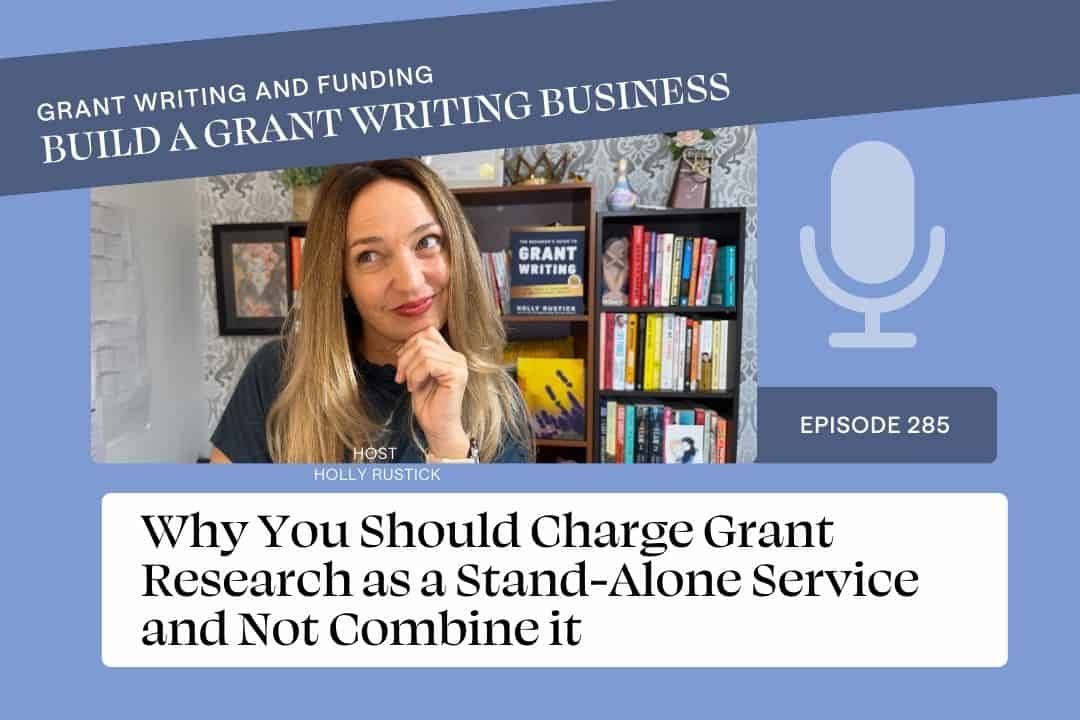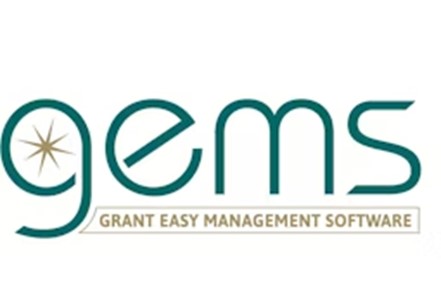Why You Should Charge Grant Research as a Stand-Alone Service and Not Combine it with Grant Writing

August 22, 2023
Welcome to another episode of Grant Writing & Funding with your host, Holly Rustick. In this episode we delve into the art and science of finding the right grants for your nonprofit or nonprofit clients.
Holly shares valuable insights on the importance of separating grant research from grant writing, and the significance of building relationships with potential funders.
She highlights the need to review and respond to grant instructions diligently, while considering practicalities like eligibility, funding amounts, and necessary documents.
Holly also introduces a grant research package offered by an organization, which includes finding fitting opportunities and providing grant writing services. Plus, she explores the power of analyzing 990s, public information from foundations, to identify potential grants and understand their priorities.
Join us as we dive into the world of grant research and equip ourselves with the tools and knowledge to secure funding for our causes.
7 Steps to Do Grant Research as a Stand-Alone Service
STEP #1: THINK ABOUT GRANT RESEARCH AS A RELATIONSHIP BUILDING EXPERIENCE
Rather than solely focusing on monetary gain, Holly encourages nonprofit organizations and consultants to align their missions with potential funders. By building genuine connections and resonating with funders’ values, the grant research process becomes more than just a transactional pursuit. This perspective shift reduces stress and panic about needing money and helps in creating long-lasting partnerships to support the organization’s mission. Tune in to learn more about the art of grant research and how to build meaningful relationships in the search for funding opportunities.
STEP #2: REACH OUT TO FUNDING SOURCES MORE THAN ONCE PER YEAR
Are you only reaching out to funding sources once a year? Doing good grant research means that you build relationships with potential funders through regular communication. Don’t just limit your contact to once a year. Instead, consider reaching out multiple times and engaging with program officers and funding opportunity announcements. This direct connection can prove to be valuable, particularly for federal grant funding sources. Don’t miss out on the opportunity to establish meaningful connections and increase your chances of securing funding!
STEP #3: REVIEW FUNDED GRANTS
Reviewing funded grants is a valuable practice. Examining awarded grants can shed light on the priorities of funding organizations and help identify untapped areas of opportunity. By exploring the names of recipients, funding amounts, and the impact of these grants, Holly demonstrates how this information can inform your own grant research and writing strategies. Discover how to set realistic goals, gauge appropriate funding amounts, and align your organization’s mission with potential funders.
STEP #4: REVIEW 990S TO SEE WHAT FUNDING WAS ACTUALLY GIVEN OUT
Doing proper grant research includes examining 990s to gain insights into the actual funding awarded by foundations. 990s are public information that contain details about grants awarded, including the amount and recipient organization. It’s important to utilize 990s to obtain accurate information about a funding source’s grant history, as they can provide more reliable information than the organization’s own website. You can access 990s on platforms like Guidestar.org or local revenue and tax offices, or through specialized grant research software like Foundant Technologies.
STEP #5: READ THE FOA/RFP AND MAKE SURE YOUR NONPROFIT IS ELIGIBLE AND IT’S A GOOD FIT
Thoroughly reviewing and understanding the funding opportunity announcement (FOA) or request for proposal (RFP) before proceeding further, is a best practice for a grant researcher. These documents, or grant applications, highlight the need to assess eligibility criteria and ensure that your nonprofit aligns with the purpose and goals of the grant. This step is crucial to save time and avoid investing resources into applications that may not be a good fit for your organization.
STEP #6: UNDERSTAND THAT GRANT RESEARCH IS AN ART AND SCIENCE, AND A HIGHLY SKILLED SERVICE
Grant research is not simply a matter of searching for available funds; it requires a deep understanding of the grant landscape and the ability to strategically identify the best opportunities for nonprofits. It is an art that involves building relationships, analyzing funding priorities, and aligning missions. At the same time, it is a science that involves meticulous research, staying updated with funding trends, and effectively utilizing resources such as the 990s to gather crucial information about grant opportunities. It is a highly skilled service that can greatly enhance the success of grant writing endeavors.
STEP #7: SEPARATE GRANT RESEARCH AND GRANT WRITING IN YOUR FREELANCE GRANT WRITING CONTRACTS
Separating grant research and grant writing in your contracts is vital to capture the importance and value of your services. By clearly delineating these services, both parties can have a clear understanding of the scope and responsibilities. This separation allows organizations to effectively track and compensate for the time and effort spent on each task, ensuring fair compensation for the grant writer and efficient use of resources. We go over how to do this in the Freelance Grant Writer Academy and the Grant Professional Mentorship programs.
What you’ll learn in this episode:
- Introduction to grant research package offered by an organization
- Details of the package, including finding 8 to 10 grant opportunities for non-profit
- Importance of having separate contracts for research and writing services
- Emphasis on keeping track of these services as separate line items in contracts
- Tips for reviewing and responding correctly to grant instructions
- Importance of assessing eligibility, funding amount, matching requirements, and necessary documents
- Consideration of practicalities such as board availability and time constraints for submissions
- Shifting perspective to align missions when considering partnerships for nonprofits or consulting clients
- Importance of focusing on resonance and building up the mission rather than just looking for financial support
- Reducing stress and panic about needing money with a shift in perspective
Resources mentioned in this episode:
- Free Grant Writing Class
- Grant Easy Management Software
- Nonprofit Consulting Conference Online
- Freelance Grant Writer Academy
- Related Episode: How Grant Research Can Be a Service You Offer Nonprofit Clients
- Related Episode: How Freelance Grant Writers Get Paid
Rate, Review, & Follow on Apple Podcasts
“Every time I listen to Holly’s show, I learn something” <– If that sounds like you, please consider rating and reviewing my show! This helps me support more people — just like you — move toward writing higher quality grants without overwhelm, and to start and grow successful grant writing businesses! Click here, scroll to the bottom, tap to rate with five stars, and select “Write a Review.” Then be sure to let me know what you loved most about the episode!
Also, if you haven’t done so already, follow the Grant Writing & Funding podcast. I’m adding a bunch of bonus episodes to the feed and, if you’re not following, there’s a good chance you’ll miss out. Follow now!“

This podcast episode is lovingly sponsored by Grant Easy Management Software (GEMS).
Break Up with Your Spreadsheet – Get GEMS Grant Easy Management Software and NEVER MISS A DEADLINE AGAIN!
Book YOUR FREE demo now! Click here.
Holly Rustick
Meet the author Holly Rustick
Work with Me
Write Grants, Get Paid.
Freelance Grant Writer Academy
Grant Professional Mentorship
JOIN OUR NEWSLETTER
Holly Rustick is a world-renowned grant writing expert and Amazon bestselling author.
Holly has been coaching grant writers how to run successful 5-6 figure businesses since 2017.
With two decades of grant writing and nonprofit experience, Holly is a popular keynote speaker for events all over the world, podcast host of the Top-Ranked Grant Writing podcast, a former university instructor, and is past president of the Guam Women’s Chamber of Commerce. She is constantly booked out to run trainings to help grant writers grow capacity, increase funding, and advance mission.
Love this post? You'll love these resources.
GET ACCESS NOW
Free Grant Writing Class
Get the proven 7 steps to eliminate anxiety and get Holly’s 20 years of secrets to start writing winning grants.
You will get the grant writing system that has helped Holly secure more than $25 million in grant funding and students earn more than $100,000,000 in funding for nonprofits around the world!
GET ACCESS NOW
Free 5-Step Checklist
OUR SPICY BELIEF IS THAT ALL GRANT WRITERS SHOULD START A BUSINESS, EVEN IF IT’S PART-TIME.
Work from home and have a massive impact on your community. Set up a grant writing business so you can start getting paid to write grants.